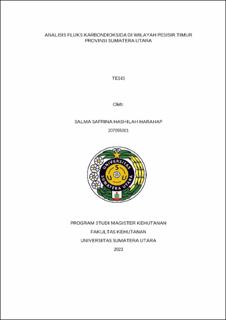Analisis Fluks Karbondioksida di Wilayah Pesisir Timur Provinsi Sumatera Utara
Assessing Sediment CO2 Fluxes in The Coastal Ecosystem of North Sumatra, Indonesia

Date
2023Author
Harahap, Salma Safrina Hashilah
Advisor(s)
Basyuni, Mohammad
Slamet, Bejo
Metadata
Show full item recordAbstract
The important role of coastal areas in regulating climate is as a CO2 absorber and as a place for carbon exchange such as the atmosphere and land. Coastal areas contribute greatly to the CO2 exchange process because of the complex interactions that occur between the atmosphere, land and oceans. An important process in the dynamics of CO2 gas between the atmosphere and seawater begins with a function of CO2 solubility and CO2 gas transfer rate at sea level or called CO2 flux. this study aimed to determine the level of CO2 flux in several land covers in the coastal areas of North Sumatra Province, to analyze the effect of sea tides and ebbs on the amount of CO2 flux, to analyze the correlation between the number and area of macrozoobenthos holes and CO2 flux. The CO2 flux data collection method was measured using the static closed chamber method. CO2 flux was analyzed using descriptive statistics and the Kruskal Wallis test. Analysis of the effect of CO2 flux at high and low tide using the paired sample T-test. A correlation test was used to analyze the relationship between the number and area of macrozoobenthos holes to CO2 flux. The highest average CO2 flux was found in natural mangrove forest land cover at 798.0897 mgCO2/m2/h, second in oil palm plantations at 537.9718 mgCO2/m2/h, third in mangrove restoration at 387.1787 mgCO2/m2/ h and the lowest was in ponds at 312.2134 mgCO2/m2/h. The high tides and low tides of seawater affect the level of CO2 flux in natural mangrove forests. Whereas in mangrove restoration, seawater high tides and low tides do not affect the level of CO2 flux. The high tides conditions in natural mangrove forests and mangrove restoration affect the level of CO2 flux. Whereas low tides conditions in mangrove natural forests and mangrove restoration, it does not affect the level of CO2 flux. Correlation test results showed that there was no significant relationship between the number and area of macrozoobenthos holes and CO2 flux.
Collections
- Master Theses [24]
